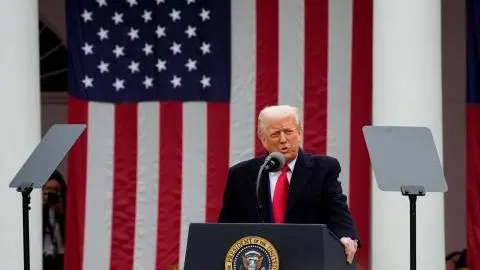Tariffs: Europe’s worst economic nightmare just came true
A US 20% reciprocal tariff on the European Union will hurt. It's worsened the eurozone's short-term outlook. Now, so much depends on European governments to push through with their planned fiscal stimulus and reforms to strengthen domestic economies
Wednesday's tariff announcements by Donald Trump should be the final reminder for Europe that the Transatlantic relationship has changed for good. And this doesn’t only apply to security and defence policies.
Since the US elections in November, it's been clear that the intended US economic policies were a kind of modern version of beggar-thy-neighbor policies, strengthening the US economy and cannibalising important trading partners. While the intended energy policies and tax cuts have not yet been implemented, today’s tariff announcements combined with earlier tariffs on steel, aluminum and automotives will hurt the eurozone economy.
Even if there are no winners in trade wars, some lose more than others. While in recent weeks, the longer-term outlook for Europe had clearly brightened with the European defence initiatives and the German fiscal U-turn, tariffs have just darkened the near-term outlook.
What do we know about the tariffs?
'Liberation Day' turned into 'Tariff Application Day' as President Trump signed an Executive Order introducing reciprocal tariffs on its trading partners. These tariffs are not applied in the pure form of matching the exact tariff differential imposed by other countries on imported goods. Instead, they include 'non-monetary' barriers such as exchange rates, technical standards, and VAT, as outlined in the soon-to-be-released USTR foreign trade barriers report. These 'discounted reciprocal tariffs', as President Trump described, cover roughly half of what the US is charged, according to the US administration. There is no well-defined end to these tariffs; they will become effective on 9 April.
Each country is viewed individually and receives its own tariff rate. During the tariff announcement at the Rose Garden, a billboard highlighted China as the worst trade offender, receiving a 'discounted reciprocal tariff' of 34%. The EU followed with a tariff of 20%, and Vietnam with 46%. It looks as if, at least for now, Canada and Mexico are not subject to today’s reciprocal tariffs.
It is not yet clear whether those newly announced tariffs will get stacked on top of already existing tariffs or whether they'll be regarded separately. To put it simply: will a tariff rate of 47.5% be paid for an imported car from Europe or 'just' 27.5%? We're not absolutely sure, but European leaders will be hoping they won't be stacked upon each other and that's certainly what the term sheet suggests.
The EU reaction
The European Union has postponed its initial round of counter tariffs until mid-April. Officials have consistently expressed their preference for negotiation and openness to dialogue. However, the EU has also made it clear that it will retaliate in kind if no solution is found.
The EU’s preferred option is a 'negotiated solution' to avoid mutual economic harm. German Finance Minister Jörg Kukies recently called for a free trade area between the US and the EU, effectively reducing tariffs to zero for both sides. While this proposal is admirable, it would likely result in lengthy negotiations. Therefore, offering to buy more goods 'made in the USA' might be a quicker way to reach a deal. However, US President Trump’s speech tonight did not really sound as if there is a lot of wiggle room for negotiations.
Not much wiggle room for negotiations
The EU has repeatedly stated that it is ready to take firm countermeasures if necessary to protect EU interests. What would this look like? As an initial step, the EU will reinstate previously suspended tariffs on a range of US goods and apply even higher counter tariffs on products such as agricultural and food items, textiles and apparel, footwear and headgear, furniture and bedding, household appliances and tools, construction and building materials, optical products, precious metals, and lighting. With 13.7% of total Extra-EU trade stemming from the US, this will significantly impact US exporters, especially if other nations retaliate similarly.
In response to the Section 232 tariffs on steel, aluminium, cars, and car parts, the EU can quickly apply retaliatory tariffs without requiring a subsidiarity check by national parliaments. The EU acts on behalf of its member states through the "Trade Enforcement Regulation," which enables the EU to suspend or withdraw concessions or other obligations under international trade agreements when third countries breach these agreements and affect the EU's commercial interests, allowing the EU to take (immediate) countermeasures.
Looking at more profound and impactful measures against US companies, the EU is considering targeting the services sector. This could involve implementing stricter regulations on Big Tech, or under the Anti-Coercion Instrument (ACI), delaying the issuance of business licenses for US companies, limiting their access to public contracts, restricting intellectual property rights or prohibiting investments in the EU altogether.
Yet, invoking countermeasures under the ACI would need the green light from a 'qualified majority' of 15 out of the 27 member states, representing at least 65% of the bloc’s population. Also, any reaction under the ACI would take some eight weeks, and it can't be triggered if Trump’s tariffs are not punitive, or their adoption is made conditional on policy changes performed by the EU and its member states.
What it means for Europe's economies
Admittedly, a lot is still unclear, and fully quantifying the impact of such a tariff tsunami, which actually brings back tariff levels of the 1930s, is almost impossible. The 20% blanket tariffs could shave off 0.3pp of eurozone GDP growth over the next two years when only focusing on the direct and indirect trade impact. Interestingly, eurozone exports to the US had increased materially ahead of tariff announcements, and the most immediate effect will be the reversal of frontloading as tariffs take effect.
But there is more to it than the direct impact. Think of the secondary effects on confidence these tariffs will already have on European consumers and businesses. Holding back consumption and investments looks likely. This would keep economic growth in the eurozone at a snail’s pace.
Earlier on Wednesday, Bloomberg reported on a possible support package from the European Commission, accompanying countermeasures to the US, that could help alleviate the impact for the sectors that would be hit hardest. If this were to be the case, it would naturally limit the short-term impact of the tariff shock, but the question remains how long it can limit the fallout of demand.
We're reducing our eurozone GDP growth forecast
The also-mentioned reforms and boosts to competitiveness would take longer to take effect and materially improve the fate of vulnerable sectors. While the devil is in the details with plans like this, structural improvements to the eurozone economy couldn’t come at a better time. For now, we are reducing our eurozone GDP growth forecast to 0.6% YoY, from 0.7% YoY, for 2025, and to 1.0%, from 1.4%, for 2026
Gauging the impact on inflation is as complicated as it will also depend on the EU’s reaction. Assuming some retaliation by the EU, inflation in Europe will also increase. However, at the same time, US tariffs could add to already high inventory levels and low capacity utilization, being the right recipe for disinflation once companies try to destock. At the same time, other countries hit by US tariffs, think China, might also try to increase exports to Europe by lowering prices. As counterintuitive as it might sound, in the longer run, a fully fledged trade war is likely to be disinflationary for Europe. But in the short term, all eyes are on the Commission’s countermeasures to gauge the impact on inflation properly. The first countermeasures will take effect mid-April, but those are relatively small as they retaliate against steel and aluminium tariffs. As the Commission has not yet announced countermeasures to today’s announcements, the jury is still out on how the overall impact on eurozone prices plays out.
Regarding the European Central Bank, the latest comments by ECB officials stress that there still seems to be a significant group supporting a pause at the next meeting, which will be held in two weeks. Monthly inflation and services inflation are still not where they should be, and many officials are still stressing that the job is just not done.
However, the call for a pause was stronger a few weeks ago when fiscal stimulus expectations brightened the outlook for eurozone growth (and inflation). With tonight’s negative trade and confidence shock and little prospect of quick negotiations, the chances that the ECB will want to push the policy interest rate further into neutral territory in two weeks have clearly increased.
This publication has been prepared by ING solely for information purposes irrespective of a particular user's means, financial situation or investment objectives. The information does not constitute investment recommendation, and nor is it investment, legal or tax advice or an offer or solicitation to purchase or sell any financial instrument. Read more
Download
Download article
2 April 2025
Our take on Trump’s ‘Liberation Day’ tariffs This bundle contains 7 Articles


